| Library / Biographies |
Alexandra David-Néel Biography
1868
October 24, in Saint-Mandé, a suburb of Paris, France, Louise Eugénie Alexandrine Marie David is born. Her father, Louis David was a French freemason, liberal journalist, teacher and Republican activist. He opposed the Coup d'Etat of Louis-Napoléon Bonaparte in 1851 and, expelled from France, he went into exile in Belgium where he married Alexandrine Borghmans.
As a child, Alexandra became passionate about the trips mentioned in the books of Jules Verne and later she dreamed of Asia at the Guimet Museum.
1873, January 26, Louis Jules, Alexandra’s brother is born. He died six months later.
1878
At age ten she was impressed by a tale of Buddha who meeting a tigress in the jungle gave his own flesh to feed her starving cubs. The idea of such sacrifice thrilled her imagination.
1883
In her youth, she was distressed by the long, idle vacations her family took. “I cried bitter tears more than once, having the profound feeling that life was going by, that the days of my youth were going by, empty, without interest, without joy,” David-Néel wrote.
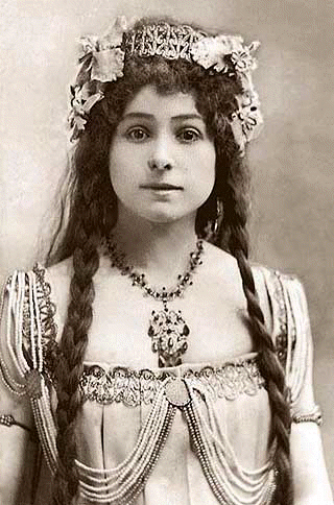
Alexandra David-Néel as a teenager, 1886At the age of 15, spending her holidays with her parents at Ostend, Belgium, she ran away and reached the port of Vlissingen in the Netherlands crossed to England. Lack of money forced her to return soon.
Alexandra starts reading her first occult material, a journal produced by the Society of the Supreme Gnosis.
1885
Alexandra again left home, this time travelling alone by train from Brussels to Switzerland. She then hiked alone over the Saint-Gotthard Pass through the Alps to the Italian lakes. Her distraught mother had to travel to retrieve her.
1886
April, David-Néel entered the Conservatoire royal de Bruxelles (Royal Conservatory of Brussels), where she studied piano and singing.
At the age of 18, David-Néel had already visited England, Switzerland and Spain on her own, and she was studying in Madame Blavatsky's Theosophical Society.
1888
Receives an offer from the Supreme Gnosis to study and she travels to London.
"She joined various secret societies – she would reach the thirtieth degree in the mixed Scottish Rite of Freemasonry – while feminist and anarchist groups greeted her with enthusiasm... Throughout her childhood and adolescence, she was associated with the French geographer and anarchist Elisée Reclus." (Brian Haughton, "A Mystic in Tibet – Alexandra David-Néel)
1889
Returns to Brussels to resume the study of music.
Elisabeth Morgan, her patron (which she called godmother), gives Alexandra the opportunity to leave home and board cheaply with a branch of Theosophical Society in the Latin Quarter of Paris, but she is not impressed.
Spends day after day at the Guimet museum studying Eastern thought and religions, history, folklore and geography. At 21, she was still struggling to find her path. Later in life she wrote that “Vocations are born, mine was born there.”
1890
Starts to study Sanskrit and Tibetan and followed different instructions at the Collège de France and at the École Pratique des Hautes Études (practical school of advanced studies) without ever passing an exam there. According to Jean Chalon, her vocation to be an orientalist and Buddhist originated at the Guimet Museum.
Alexandra goes through a period of depression and has suicidal thoughts but decided not to kill herself considering that she would reincarnate to suffer the consequences and second, suicide would be like “quitting post like a deserter.”
1891
Alexandra inherits a significant sum of money on the death of her “godmother.” She plans to use the money to visit India, while her parents wish she invest in a tobacconist shop.
Alexandra gets involved with a group led by a popular guru, Sri Ananda Saraswati, whose followers used drugs for the purpose of obtaining visions of astral travel. She used hash once and allegedly never again after that.
She travels for over a year through Ceylon and India, to the Nepal-Sikkim border.
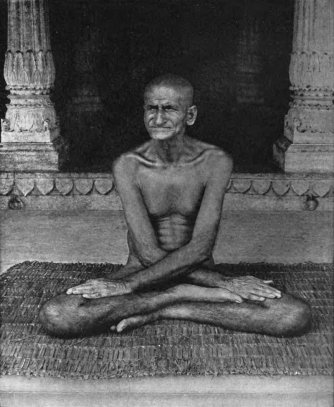
Swami Bhaskarananda of Varanasi.Studies yoga in Benares with Swami Bhaskarananda Saraswati (1833–1899) a noted 19th-century sannyasin and saint. After spending all her funds, Alexandra returns to Europe, again dependent on her parents.
1893
Back in Brussels, Alexandra writes to Annie Bessant, Madame Blavatsky’s successor, to ask her advice on meditation.
Her sympathy for the anarchistic ideas of the time makes her known to police in Brussels and Paris who retained dossiers on her and passed on to the British almost twenty years later.
1894
To help her parents who were experiencing setbacks, David-Néel, who had obtained a first prize for singing, takes the position of first singer at the Hanoi Opera House (Indochina) during the seasons 1895–1896 and 1896–1897 under the name Alexandra Myrial.
She interprets the role of the Violetta in La Traviata (by Verdi), then she sang in Les Noces de Jeannette (by Victor Massé), in Faust and in Mireille (by Gounod), Lakmé (by Léo Delibes), Carmen (by Bizet), and Thaïs (by Massenet).
1897
From 1897 to 1900, she lives with the pianist Jean Haustont in Paris, writing Lidia with him, a lyric tragedy in one act, for which Haustont composed the music and David-Néel the libretto.
1898
Published “Pour la vie”, a libertarian essay.
1899
Alexandra obtains an engagement to sing at the opera of Athens from November 1899 to January 1900.
1900
In July she accepts an engagement with municipal opera of Tunis. Soon after her arrival in the city, she meets a distant cousin, Philippe Néel, chief engineer of the Tunisian railways and her future husband.
1902
She gives up her singing career and assumes artistic direction of the casino of Tunis for a few months.
1904
On 4 August 1904, at age 36, she marries Philippe Neél de Saint-Sauveur, whose lover she had been since 15 September 1900. Their life together was sometimes turbulent but characterized by mutual respect. She did not want children, aware that motherhood was incompatible with her need of independence and her inclination to education.
December 21st, Alexandra’s father dies. She inherits twenty thousand francs.
1905
Alexandra’s early mentor, Elisée Reclus dies and Alexandra travels to Belgium to pay respects.
1906
Alexandra travels to London to study about Chinese philosopher Meh-ti. She becomes befriends Dr. T. W. Thys Davis and his wife, Caroline, who founded the Pali Text Society in 1888. In London, Alexandra also meets the Japanese writer on Zen, D. T. Suzuki. Later she will visit him in Japan.
1907
Alexandra goes through a period of depression feeling that she is getting “ugly, old and poor”, without a purpose in life. She resumes her neglected oriental studies at the Collège de France with Professor Sylvain Levi. He would remain her mentor until his death.
1909
In December her work “Contemporary Buddhist Thinkers” is published at Mercure.
1910
Alexandra lectures at the Theosophical Society in Paris and London.
1911
Her book “Le modernisme bouddhiste et le bouddhisme du Bouddha” is published in Paris. But she feels unhappy that her entourage, including herself too, were just “poseurs” – armchair Buddhists.
Philip suggests Alexandra to visit India to perfect her oriental languages and he offers to pay for one-year expenses.
By August Alexandra David-Néel is on her way to India to further her study of Buddhism. But, thanks to her generous husband, instead of one year, she is able to travel around Asia for 14 years. During this time Philip receives thousands of pages of handwritten notes and articles to forward to journals.
She arrives in Colombo then travels North along the East coast to Madurai and Madras. She is displeased with the Brahmanic system and finds Vedantins “deplorable, anti-human, anti-social…” She prefers to stay at the Adyar Theosophical Society instead in homes of Brahmins whose habits she finds repulsive to eat in.
November 11th, Alexandra meets Sri Aurobindo Ghose at his home in Pondicherry. She is impressed by his “rare intelligence belonging to that uncommon breed of rational mystics with which I am in sympathy…” and ignores the warning of Madras police about visiting the house of “extremist” Aurobindo.
Following her visits to Aurobindo, Indian police make secret inquiries in Paris, revealing elements of her radical past, and she is place under surveillance by the Government of India.
By New Year Alexandra arrives in Calcutta, but is not impressed, seeing the city as a “collection of tattered rags.”
She is welcomed by Sir John Woodroffe, the Justice of Calcutta High Court. She describes Woodroffe as someone who was openly a Śākta and devotee of Kālī, and who practiced rites to that goddess.
1912
In March, while still in Calcutta, Alexandra receives an offer from the Hardwar Sanskrit College to study Buddhism.
She arrives at the royal monastery of Sikkim, where she befriends Maharaj Kumar (crown prince) Sidkeong Tulku Namgyal, the eldest son of the sovereign (Chogyal) of this kingdom (which would become a state of India), and traveled to many Buddhist monasteries to improve her knowledge of Buddhism.
Sidkeong, then the spiritual leader of Sikkim, a reformer whose model was Milarepa, was sent to the meeting with Alexandra David-Néel by his father, the Maharaja of Sikkim, having been told about her arrival in April 1912 by the British resident at Gangtok. On this first encounter, their mutual understanding is immediate: Sidkeong, eager for reformation, accepts Alexandra's advice, and before returning to his occupations, he left behind the Lama Kazi Dawa Samdup as a guide, interpreter and professor of Tibetan.
On April 15, Lama Kazi Dawa Samdup accompanies Alexandra David-Néel to Kalimpong, where she meets the 13th Dalai Lama in exile. She asks so many questions that Dalai Lama asks her to put them in writing and agrees to answer them fully. He strongly advises her to learn Tibetan, an advice she will follow.
In late May, she goes to Lachen, meeting Lachen Gomchen Rinpoche, the superior (gomchen) of the town's monastery, with E. H. Owen as interpreter, a reverend who replaced the absent Kazi Dawa Samdup.
Leaves Sikkim in November and goes to Benares after extensive travel to Sikkim and Nepal, deeply disappointed for not being able to enter Tibet. She returns to the study of Sanskrit and Vedanta.
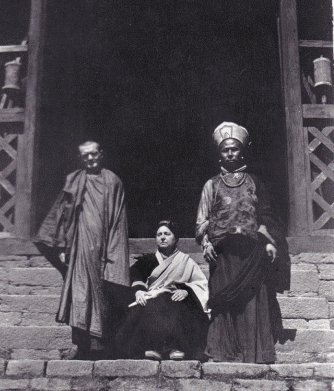
Alexandra David-Néel with Silacara Bhikkhu and her main Guru Gomchen Rinpoche of Lachen, on right. (Sikkim 1913). In her cave, she practiced Tibetan yoga. She was sometimes in tsam, that is to retreat for several days without seeing anyone, and she learned the technique of tumo (mystic heat). As a result of this apprenticeship, her master, the Gomchen of Lachen, gave her the religious name of Yeshe Tome, "Lamp of Sagesse", which proved valuable to her because she was then known by Buddhist authorities everywhere she went in Asia.
1913
She writes to her husband that she is missing a little the quietude of their marriage, the clean house and good dinners, but also that it would be a “half-asleep” life eroded by an undercurrent of “infinite despair” for never being herself.
Alexandra makes rapid progress in Sanskrit thanks to tutoring with a very knowledgeable elderly pundit who came to her twice a day at the Theosophical Society.
On 3 December, when his father was about to die, Sidkeong called Alexandra David-Néel for help, and asked her for advice in bringing about the reform of Buddhism that he wished to implement at Sikkim once he came to power. Returning to Gangtok via Darjeeling and Siliguri, David-Néel was received like an official figure, with guard of honor, by Sidkeong.
She starts studying Tibetan that she finds to be much easier than Sanskrit. With more time available she goes to some monasteries and explain the Buddhist sutras to young monks.
1914
In January, Alexandra intends to visit Bhutan and British officials are supportive of her research, but the Maharaja of Bhutan is afraid of complications if a woman without an European escort wanders about Bhutan, and especially displays a desire to visit monasteries. Not being able to visit Bhutan she turns her attention to south of Tibet.
On February 10th the maharaja of Sikkim dies and her friend, Oxford-educated prince Sidkeong, ascends to the throne. The new maharaja is an admirer of Tsong Khapa, the Yellow Hat reformer of Tibetan Buddhism, while all the monasteries in the kingdom are red Hat and venerate Padma Sambhava.
On December 14 Alexandra is shocked to learn that after a brief and unexplained illness (she suspects poisoning) the young maharaja of Sikkim died. She suffers deeply and determines her to take the life of a hermit. She becomes the disciple of the Third Lachen Gomchen Rinpoche, a revered mystic, who she met previously in May 1912.
After some difficult start due to language barrier, master and disciple settle for other means of communication and they are pleased with one another. She thinks that “what he says is marvelous, audacious, frightening.” He told her “you have seen the ultimate and supreme light. It is not by one or two meditations that you have arrived at the conceptions you express. After this, there is nothing more.” She settles in a cave about a mile below Gomchen’s one – and agrees on terms of discipleship: absolute obedience, no trips without his permission. If she proved herself deserving, the master would give her the secret oral teachings.
Aphur Yongden a 15 years old Tibetan enters her service, whom she would later adopt as her son.
Starting from November 1914 she lives as a hermit in the Himalayas. She makes great progress in learning Tibetan and can converse fluently with Gomchen. Her feelings go from repulsion for this “truly ugly [man] dressed in filthy robes” to awe at “the clarity of his thought”. She feels that this guru is truly connecting her the long hierarchy of masters before him.
1915
Around Christmas Eve she is in despair and homesick. She suffers from rheumatism, fever and nausea. She expects to return home when the sea lanes become safe. But once trapped by the heavy Himalayan snows, she starts making great progress. In spring she spends a night practicing tumo until dawn.
1916
By summer she feels that her role of a disciple is coming to an end. Her lama also hinted her to get back on the road. Many years later she condensed her two-year experience in a book titled “The Secret Oral Teachings in Tibetan Buddhist Sects”.
On July 13th Alexandra, accompanied by Yongden, sets out for Shigatse, in south-central Tibet on an invitation from Panchen Lama, without the approval from the British representative in Sikkim. They arrive at Tashilhunpo near Shigatse on July 16th without other opposition than weather and meet the Panchen Lama.
She is enchanted by Panchen lama’s refinement, “barbaric splendor that reigned in the temples,” dialogues with the monks, “special psychic atmosphere of the place,” and immense libraries, but yearns for the solitude of her hermitage and Gomchen’s presence.
Panchen Lama is impressed with her sincerity and knowledge of scriptures, grants her an honorary doctorate from Tashilhumpo university and invites her to remain in Tibet under his patronage. But she realizes that lama does not have the political authority to make that happen.
On July 26th Alexandra and Yongden travel back to Sikkim to find her hermitage ransacked and Gomchen in retreat, not seeing anyone. Due to crossing into Tibet without authorization, she receives notice from British government that she has two weeks to leave the country.
1917
Impossible to return to Europe during World War I, Alexandra David-Néel and Yongden left Sikkim for India and then Japan, arriving at Kobe on February 6th.
She meets the philosopher Ekai Kawaguchi who had managed to stay for eighteen months in Lhasa as a Chinese monk in disguise a few years earlier. David-Néel and Yongden subsequently go to Korea.
By end of September they renew passports in Seoul and in early October arrive in Peking, China, where she meets a rich Tibetan Lama from northeastern Tibet. He invites Alexandra to join his armed caravan on the return to Kum Bum, where she could study at the monastery. In return she would help him write a book on astronomy.
1918
In January Alexandra receives news that her senile mother had died a year earlier.
After numerous adventures, sickness and 1600 miles of travel, Alexandra and Yongden arrive at Kum Bum, the birthplace of Tsong Khapa.
Life among the monks at Kum Bum was almost paradise for lama Alexandra: waking up early before dawn, one hour of walking or meditation, English breakfast at nine, doing translations until noon, then a hot tub break; then more translation work of rare manuscripts from Kum Bum library. In the afternoon she had a vegetable soup and fruits for desert. Nine was the time for bed. Sometimes meat was served.
1919
Alexandra makes some trips and short expeditions around Kum Bum. As the civil war in China was heating up, anarchy and brigandage flourished, and she and her attendants had to carry guns for self-defense. Along the border of Amdo and Kamsu, they meet famine and cholera, while tigers and leopards come out of the woods to eat corpses.
Yongden spreads rumors that the nun is actually a sorceress, while Alexandra displaying her 108-piece necklace of human skull, is blessing the crops and cattle, “exorcising” bad spirits and divining the reincarnation of the dead, for a fee of food.
By September Alexandra and Yongden are safely back at Kum Bum.
1920
During the winter she experiments with a type of very strict meditation and ends up being frightened by her own creation (tulpa).
By autumn the crops fail, and people die of starving and cholera. But Alexandra is not in the mood to leave Tibet for Europe yet. She writes to her husband that she can’t tear herself from Tibet and realizes that her stay at Kum Bum is nearing the end.
1921
Alexandra translates Prajñāpāramitā of Nāgārjuna with Yongden’s help. She starts a long journey through Eastern Tibet, Mongolia, western China and southern Tibet.
1923
In October Alexandra and Yongden start their 2000 kilometers journey to Lhasa, begging their way to destination, encountering and camping with brigands and nomad shepherds. To succeed in reaching her dream destination she learned from many previous failed attempts made by other westerners.
Her reasons for the journey were prestige, fame, pleasure of revenge on those who previously forbade her access and she wanted “to show what the will of a woman could do.” But also, she was fascinated by the “wilderness [that] speaks with a different voice than the boulevards of Paris.”
In Po country, after trance walking for nineteen hours straight through deep snow and whipping winds they stop to make a fire, but the flint and steel are wet. Yongden tells Alexandra to warm herself with the practice of tumo reskiang that she was initiated in.
While Yongden went away to collect cow droppings, she tries to remember the practice that she lately neglected in favor of warm clothes. “Soon I saw flames arising around me; they grew higher and higher; they enveloped me, curling their tongues above my head.” With the flint and steel now dry, she started the fire, to Yongden amazement.
1924, February:
Alexandra and Yongden arrive in Lhasa and mix with a crowd of pilgrims coming to celebrate the Monlam Prayer Festival. Excited, Alexandra spots the Potala palace with the golden roofs glistening in the sun.
They stay in Lhasa for two months visiting the holy city and the large surrounding monasteries: Drepung, Sera, Ganden and Samye. Dalai Lama who returned from exile in 1913, knew her well, but he didn't know that she was in Lhasa and she could not reveal her identity.
Despite her face smeared with soot, her yak wool mats, and her traditional fur hat, she is finally unmasked (due to too much cleanliness – she went to wash herself every morning at the river) and denounced to Tsarong Shape, the Governor of Lhasa. By the time the latter acted, David-Néel and Yongden had already left Lhasa for Gyantse.
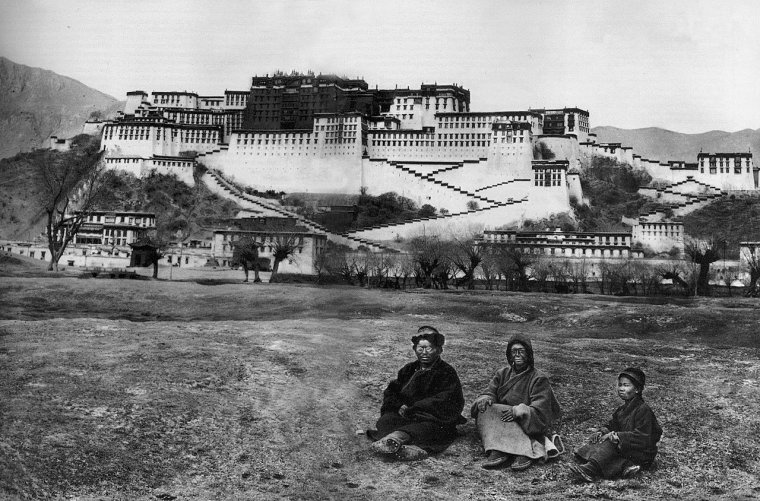
Yongden (left) and Alexandra David-Neel (center) with Potala Palace in background, in 1924.
March 12, writes to her husband that she is leaving Lhasa and that the “town is without great interest… the famous temple of Jo [Khang] is nothing marvelous. The palace of the Dalai Lama, despite richly decorated interior is nothing in particular. I have no curiosity about Lhasa.” She assures her husband that this time she is really coming home.
In May 1924, the explorer, exhausted, "without money and in rags", is accommodated together with her companion at David Macdonald’s (British trade agent in Tibet) home for a a couple of weeks. She arrives in Northern India through Sikkim partly thanks to the 500 rupees borrowed from Macdonald and to the travel papers that he and his son-in-law, captain Perry, obtain for her.
Alexandra and Yongden arrive in Gangtok, Sikkim. Charles Bell, the British resident reverses his predecessor order of expulsion and invites Alexandra to stay as long as she wishes. With the old maharaja, Lama Dawasandup and Sidkeong dead, Gangtok is not anymore as attractive as before.
August 15th, Alexandra writes to her husband that she is coming home to write the books that the American editors are asking for. She feels attracted to America for financial reasons and also because it “better suits my character and affinities.”
In October, in Calcutta she is excited to see the newspapers filled with her name.
1925
In February Alexandra and Yongden arrive in Bombay. The Revue de Paris asks for her Tibetan and Asian memoirs; an American magazine offers 375 dollars for three articles. Her reputation is soaring.
May 4th, the two arrive in Valencia, Spain, but the Spanish customs direct them to Le Havre after seeing the huge amount of luggage and artifacts.
In autumn, Alexandra gives a series of very successful conferences under the sponsorship of Professor Syilvain Levi. Yongden also attracts crowds with Tibetan poetry and anecdotes about ngagspas.
She receives the Award Monique Berlioux of the Académie des sports. Although she was not a sportswoman in a strict sense, she is part of the list of the 287 Gloires du sport Français.
1926
She speaks before crowds at Collège de France, the Guimet and the Theosophical society. But she is missing her tent, horses and the wilderness. In March the first of five articles for the American magazine Asia, appears with the title “A Woman’s Daring Journey into Tibet.”
1927
The account of her adventure becomes the subject of a book, “My Journey to Lhasa” is published in Paris, London and New York, but is met with disbelief of critics who have a hard time accepting the stories about such practices as levitation and tumo, the increase of body temperature through meditation to withstand cold.
1928
In May Alexandra buys a small house in Digne-les-Bains (Provence) which she calls Samten-Dzong or "fortress of meditation", the first hermitage and Lamaist shrine in France according to Raymond Brodeur. There she writes several books describing her travels.
The president of France, Gaston Doumergue, a great admirer of Alexandra, makes available to her sixty thousand francs to travel to Siberia and Mongolia to study the tribes of Soviet Central Asia, but due to turmoil in the area Moscow denies her visa.
1929
Her most famous and beloved work, Mystiques et Magiciens du Tibet (Magic and Mystery in Tibet) is published by Plon.
1930
Initiations Lamaïques (Initiations and Initiates in Tibet) appears published by Adyar house. Less popular than the previous book, is more precise in observations and methods of Tibetan Buddhism. She is keen to clarify misconceptions of the term “initiation” insisting that “the angkur is above all, the transmission of a power, a force, by a kind of psychic process.”
1931
Magic and Mystery in Tibet is published in New York, which becomes Alexandra’s most popular book translated in several other languages.
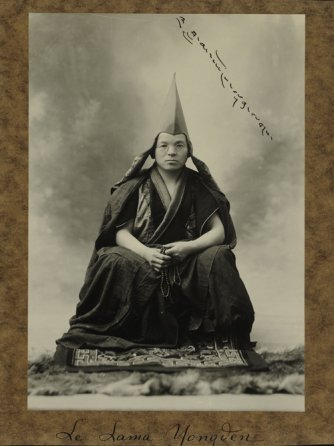
Lama Yongden in 1933. With Yongden’s help, Alexandra writes La vie Surhumaine de Guésar de Ling le Héros Thibétain (The Superhuman Life of Gesar of Ling) published in 1931 in France and in 1934 in England. The book relates a prophecy about Gesar, the vision of a new Genghis Han that will conquer the world.
1933
Grand Tibet, Au pays des brigands-gentilshommes (Tibetan Journey), published in Paris, recounts the adventures after leaving Kum Bum monastery in 1921 and travel with merchants and brigands.
1935
Le lama au cinq sagesses is a book coauthored with Yongden, written in the form of a novel that relates the life of Mipham, a tibetan who turns to a life of religion after an encounter with a snow leopard and a hermit.
1936
Buddhism: Its Doctrines and Its Methods that appears in France and in 1939 in United States, in English, is about the principles of Theravada school, as practiced in Sri Lanka, Burma and Thailand.
1937
On January 9, aged sixty-nine, Alexandra David-Néel decided to leave for China with Yongden via Brussels, Moscow and the Trans-Siberian Railway. Her aim was to study ancient Taoism. She found herself in the middle of the Second Sino-Japanese War and attended the horrors of war, famine and epidemics.
Fleeing the combat, she wandered through China on a shoestring budget. When the Chinese paper money become worthless and cut off from Peking unable to cash checks, they live on boiled rice and roots they dig up.
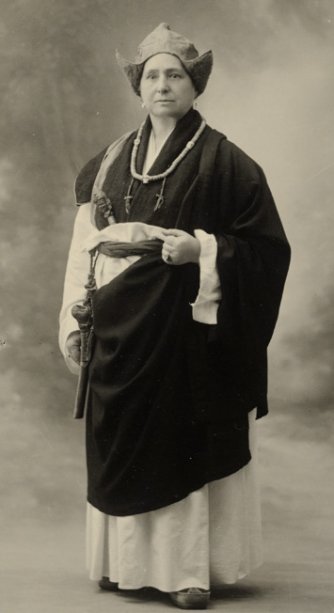
Alexandra David-Néel in Tibet, 1933 The Chinese journey took course during one and a half years between Beijing, Mount Wutai, Hankou and Chengdu.
1938
Encouraged by the success of Mipham, Alexndra and Yongden write a second novel: Magie d'amour et magie noire; Scènes du Tibet inconnu (Tibetan Tale of Love and Magic).
On 4 June they go back to the Tibetan town of Tachienlu for a retreat of five years. But they found the place crowded with refugees and monasteries accommodating more soldiers than monks.
In November they stay in an unheated hermitage, practically freezing. She is affected with arthritis and unable to practice tumo. Constrained by events, she writes “I don’t know where to turn.” After few weeks they find shelter with English missionaries and later with French Catholic nuns.
1939
By midsummer, between air raids, she completes Sous des nuées d'orage; Récit de voyage (Under the Storm Clouds) and in November she is able to mail the French manuscript by diplomatic mail to Paris.
1940
Storm Clouds appears in spring, but due to the war, the book is not widely noticed.
1941
On February 14th, she receives a telegram from her niece that her husband has died. “I have lost the best of husbands, my only friend,” she cries.
By August she suffers again of neurasthenia and kidney pain. She is displeased with Yongden who appears to have turned to drinking.
Alexandra and Yongden spend their time in Chengdu completing the Tibetan grammar and a book titled A l’ouest barbare de la vaste Chine, a study of the native tribes on the borderlands of China and Tibet.
1945
The couple arrive in Calcutta with the help of the French government, awaiting the return to France. The life in the wilderness of Tibet was not possible for her anymore.
1946
Alexandra David-Néel is able to travel back to India thanks to Christian Fouchet, French Consul at Calcutta, who became a friend; they stayed in touch until David-Néel's death.
June 30th, Alexandra and Yongden board the airplane for Paris saying goodbye to India of her youth, wondering “Am I living or already dead?... Am I wandering in the bardo? No, I am leaving, it is true.” They return to live at “Samten Dzong” in Digne.
1949
Between 1949 and 1954, several books published:
• Au coeur des Himalayas; Le Népal,
• L'Inde hier, aujourd'hui, demain
• Textes tibétains inédits ("unpublished Tibetan writings"), an anthology of Tibetan literature including, among other things, the erotic poems attributed to the 6th Dalai Lama.
• Le vieux Tibet face à la Chine nouvelle, in which she gives "a certain and documented opinion" on the tense situation in the regions once visited by her.
• La puissance de néant, by Lama Yongden (The Power of Nothingness), a novel.
• Grammaire de la langue tibétaine parlée
1955
In early October Yongden dies of kidney failure at age of fifty-six. Yongden's ashes were kept safe in the Tibetan oratory of Samten Dzong, awaiting to be thrown into the Ganges, together with those of David-Néel after her death.
With age, David-Néel suffered more and more from articular rheumatism that forced her to walk with crutches. "I walk on my arms", she used to say. Her work rhythm slowed down: she didn't publish anything in 1955 and 1956, and, in 1957, only the third edition of the Initiations lamaïques.
In April 1957, she left Samten Dzong in order to live at Monaco with a friend who had always been typing her manuscripts, then she decided to live alone in a hotel, going from one establishment to the next, till June 1959, when she was introduced to a young woman, Marie-Madeleine Peyronnet, who she took as her personal secretary.
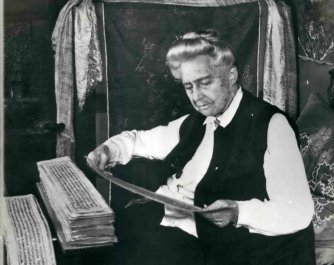
Alexandra at her home in Digne, 1968She would stay with the old lady until the end, "watching over her like a daughter over her mother – and sometimes like a mother over her unbearable child – but also like a disciple at the service of her guru", according to the words of Jacques Brosse. Alexandra David-Néel nicknamed her "Turtle".
At the age of a hundred, she applied for renewal of her passport to the prefect of Basses-Alpes.
Alexandra David-Néel died on 8 September 1969 at three in the morning, almost 101 years old.
In 1973, her ashes were brought to Varanasi by Marie-Madeleine Peyronnet to be dispersed with those of her adopted son into the Ganges.
Books published post posthumously
• 1970 En Chine: L'amour universel et l'individualisme intégral: les maîtres Mo Tsé et Yang Tchou
• 1972 Le sortilège du mystère; Faits étranges et gens bizarres rencontrés au long de mes routes d'orient et d'occident
• 1975 Vivre au Tibet; Cuisine, traditions et images
• 1975 Journal de voyage; Lettres à son Mari, 11 août 1904 – 27 décembre 1917. Vol. 1. Ed. Marie-Madeleine Peyronnet
• 1976 Journal de voyage; Lettres à son Mari, 14 janvier 1918 – 31 décembre 1940. Vol. 2. Ed. Marie-Madeleine Peyronnet
• 1979 Le Tibet d'Alexandra David-Néel
• 1981 Secret Oral Teachings in Tibetan Buddhist Sects
• 1986 La lampe de sagesse





